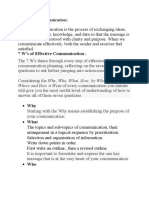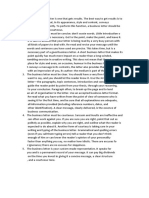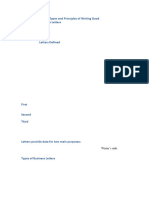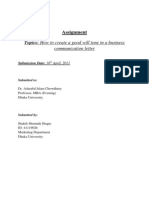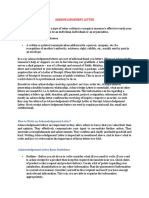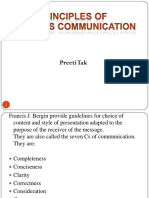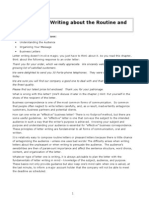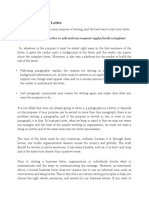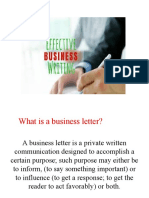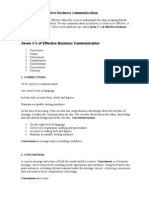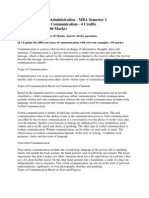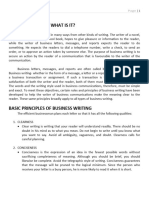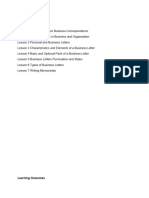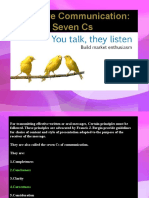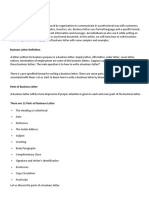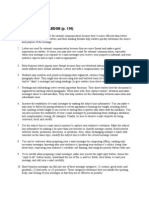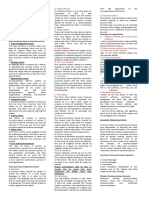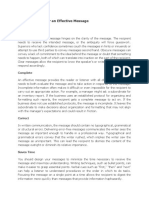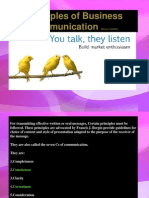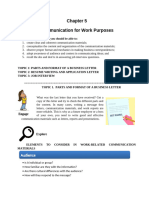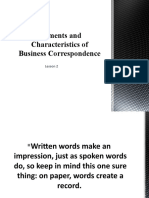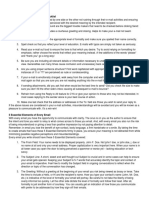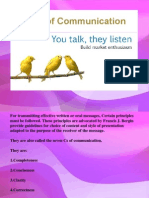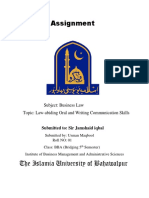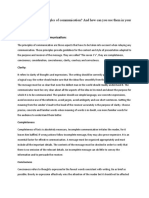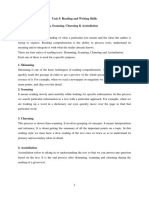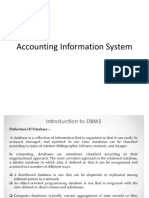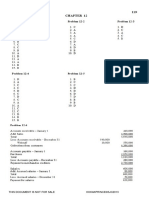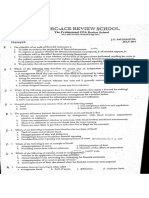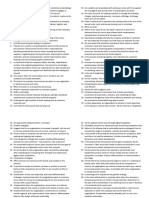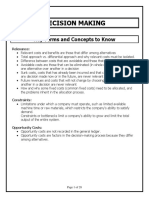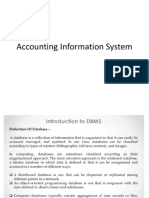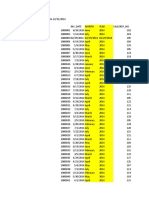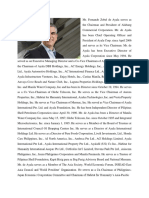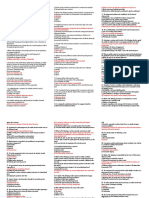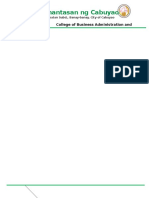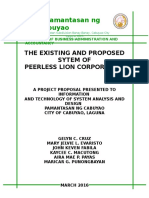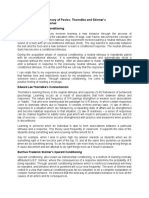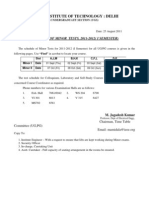Eng4 Sho2
Eng4 Sho2
Uploaded by
Gelyn CruzCopyright:
Available Formats
Eng4 Sho2
Eng4 Sho2
Uploaded by
Gelyn CruzOriginal Description:
Original Title
Copyright
Available Formats
Share this document
Did you find this document useful?
Is this content inappropriate?
Copyright:
Available Formats
Eng4 Sho2
Eng4 Sho2
Uploaded by
Gelyn CruzCopyright:
Available Formats
ENG4 Business, Technical and Report Writing
QUALITIES OF EFFECTIVE LETTERS
The test of an effective letter is the impression it makes on the reader. The letter is effective
when (1) it moves the reader to act, to know, or to feel exactly as the writer intend, and (2) it
leaves the reader with good feelings towards the writer and the organization represented. Such
results depend largely on the content of the letter and on the writers ability to express ideas in
ways that are acceptable to the reader.
1. CONCISENESS is the expression of an idea in the fewest possible words without
sacrificing completeness of meaning.
Concise messages make each word count. Only the necessary information is included.
Unimportant words, phrases, clauses and ideas are omitted. Concise letters go straight to
the point, using precise words, short sentences and brief paragraphs. They have more
impact because they save time and hold the readers attention.
Examples: I wish each and every person who receives this notice and has a suggestion to
make, to state what he has to say on the enclosed card, sign it, and drop it in the
mail at once so that I may know his opinion as soon as possible. (48 words)
Improved: Please write your suggestions on the enclosed card and mail it at once. (13
words)
2. CORRECTNESS your letters should be correct in its physical make up. Your letters should
be free of all errors in spelling, punctuation, capitalization, grammar, sentence and
paragraph structure. Above all, the dates, names and facts in the letters should all be
accurate.
3. COHERENCE means order and connection. Sentences and paragraph should hang
together; that is the ideas are clearly related and the thought flows naturally and freely
from the beginning of the message to the end. A message is coherent if the sentences are
arranged in an orderly manner; that is, if the reader can follow the thought of the letter as
it is developed from sentence to sentence.
4. COMPLETENESS Nothing is more frustrating than to receive only a partial reply to an
inqury or be unable to make a decision because an important information has been
omitted. Incomplete information can cause delays, loss of goodwill, or loss of business.
Incomplete messages also send a negative message that the writer is careless.
Completeness sends a message that the writer is competent, efficient person.
5. CLARITY clear writing is one that your reader will understand in one reading. There
should be no doubt in his mind as to what you mean. When you use big, technical, and
unfamiliar words the reader will have difficulty understanding your message. Therefore,
write to express not to impress. Avoid ambiguity, vagueness or doubt.
Three
suggestions for writing clearly:
present one idea in each sentence
arrange sentences in a manner easy to follow, be coherent
use simple, familiar words
6. COURTESY is a mental attitude. It implies respect and helpfulness. Courtesy in letter
writing consists in using words and phrases that indicate a willingness to serve. It likewise
means avoidance of negative statements and those that may offend, humiliate or belittle
the reader. A courteous letter always gains goodwill. Be considerate of the readers
interests and feelings always.
Use the following pleasant words as often as possible:
thank you
please
promptly
appreciate
glad
benefit
pleasure
considerate generous
service
happy
delighted
7. CONSIDERATION goes beyond courtesy. Whereas courtesy involves using words like
please and thank you, consideration means having empathy being sensitive to the
readers attitudes and feelings. It means putting yourself in the place of the reader.
A considerate letter emphasizes the you approach it writes from the viewpoint of the
reader. A considerate letter is helpful it anticipates questions or concerns the reader may
have and responds to them before a problem develops.
Suggestions on how to have the you attitude: before writing,
consider the person to whom you are writing: age, sex, occupation, environment, and
habits.
consider why he should be interested in your letter or product
consider what you should say that will arouse his interest
carefully plan how you should say it
A considerate letter is also tactful. Tact is a keen sense of what to do or say in order to build
goodwill and to avoid being offensive.
8. TIMELINESS
How would you feel when you receive a reply to an inquiry, to a complaint, or to a request
within a few days? Would you feel important? Will you feel good about the person or
organization that is responding? Prompt and timely messages convey positive feelings.
On the other hand, even the most courteous, considerate and tactful message may be
ineffective if the receive had to wait too long for it and it arrives after he no longer has a
need for it. Recognize the importance of timeliness. Deal with situations as they arise and
answer incoming letters promptly. A letter should be written when it is needs. A message
that is received after the deadline or after the information is no longer necessary, is a
waste of time and money.
You might also like
- 7Ws and 7 Cs of CommunicationDocument5 pages7Ws and 7 Cs of CommunicationQadeer AhmadNo ratings yet
- Marketing CasebookDocument34 pagesMarketing CasebookGandhi MardiNo ratings yet
- Business CorrespondenceDocument55 pagesBusiness Correspondencechuckpino67% (3)
- An Earth Schooling KG SAMPLEDocument35 pagesAn Earth Schooling KG SAMPLEearthschooling100% (1)
- MODULE 10-Simulating The Philippine WorkplaceDocument16 pagesMODULE 10-Simulating The Philippine WorkplacecamillaNo ratings yet
- LNC COM 101-WK 13-Simulating The Philippine WorkplaceDocument17 pagesLNC COM 101-WK 13-Simulating The Philippine WorkplaceNovelyn Degones DuyoganNo ratings yet
- 9C's of B.communicatonDocument4 pages9C's of B.communicatonMasharib KhanNo ratings yet
- Business CorrespondanceDocument12 pagesBusiness CorrespondanceSony RoseNo ratings yet
- A Good Business Letter Is One That Gets ResultsDocument1 pageA Good Business Letter Is One That Gets ResultsmuditNo ratings yet
- Barriers N 7 CS ofDocument30 pagesBarriers N 7 CS ofMaryam ShahzadiNo ratings yet
- 7 C's of Business LetterDocument3 pages7 C's of Business LetterGladys Forte100% (2)
- Module 4-Business Letters and Reports What Is A Business Letter?Document23 pagesModule 4-Business Letters and Reports What Is A Business Letter?CherianXavierNo ratings yet
- MC-Module 4 - Business ReportsDocument23 pagesMC-Module 4 - Business ReportsCherianXavierNo ratings yet
- Business Letters courseDocument5 pagesBusiness Letters coursememma8508No ratings yet
- Good Will ToneDocument4 pagesGood Will ToneShakib ShoumikNo ratings yet
- PSEL August-December 2023Document51 pagesPSEL August-December 2023Lokesh PatelNo ratings yet
- Acknowledgement LetterDocument10 pagesAcknowledgement LetterCatherine BribonNo ratings yet
- Acknowledgement LetterDocument10 pagesAcknowledgement LetterCatherine BribonNo ratings yet
- Business Com Lecture 2 and 3Document27 pagesBusiness Com Lecture 2 and 3Salman ShahNo ratings yet
- 7 C's in CommunicationDocument12 pages7 C's in CommunicationHammad Ali ShahzadNo ratings yet
- 7 C'sDocument10 pages7 C'svikrantNo ratings yet
- 7 C's PDFDocument10 pages7 C's PDFVikrant Dani90% (20)
- 10 Letter Writing - Writing About Routine and PleasantDocument22 pages10 Letter Writing - Writing About Routine and PleasantCassandra FernandesNo ratings yet
- By: Miss. Kinza ShoukatDocument29 pagesBy: Miss. Kinza ShoukatSheraz HassanNo ratings yet
- Technical Report WritingDocument15 pagesTechnical Report WritingWali UllahNo ratings yet
- The Nature of Business EnglishDocument11 pagesThe Nature of Business EnglishJunmarie EdrozoNo ratings yet
- Body of A Business LetterDocument8 pagesBody of A Business LetterIqra AliNo ratings yet
- Business LettersDocument14 pagesBusiness LettersJustine Manicad RobielosNo ratings yet
- Communication: 7 C'S of CommunicationDocument5 pagesCommunication: 7 C'S of CommunicationMobeen EjazNo ratings yet
- Effective Business CommunicationDocument20 pagesEffective Business CommunicationRushabh VoraNo ratings yet
- Master of Business Administration - MBA Semester 1 MB0039 - Business Communication - 4 Credits Assignment Set-1 (60 Marks)Document18 pagesMaster of Business Administration - MBA Semester 1 MB0039 - Business Communication - 4 Credits Assignment Set-1 (60 Marks)Vaisakh Mannath MNo ratings yet
- 7 CsDocument3 pages7 Csgamesforkids927No ratings yet
- Business LetterDocument15 pagesBusiness LetterNirnoy ChowdhuryNo ratings yet
- Lesson 2 Personal and Business LetterDocument1 pageLesson 2 Personal and Business Letteranecdota110619100% (1)
- Business WritingDocument7 pagesBusiness WritingRhea PintoNo ratings yet
- Chapter 3 ReportDocument12 pagesChapter 3 ReportJunaifa PacasumNo ratings yet
- 7 Cs of Effective CommunicationDocument10 pages7 Cs of Effective CommunicationHemantkumar JainNo ratings yet
- Business Communication: Assignment On Different Kinds of Business WritingsDocument24 pagesBusiness Communication: Assignment On Different Kinds of Business WritingsJyoti YadavNo ratings yet
- Parts of Business LetterDocument6 pagesParts of Business LetterVhea Dianne Pantoja ManahanNo ratings yet
- CH 6 Text Answer KeyDocument2 pagesCH 6 Text Answer KeyĐăng PhạmNo ratings yet
- Business Letters1Document5 pagesBusiness Letters1Kim Ivan GerongNo ratings yet
- Characteristics of Effective Business MessagesDocument4 pagesCharacteristics of Effective Business MessagesTebogo MaengeNo ratings yet
- 7CsofBusinessCommunication Type 1Document10 pages7CsofBusinessCommunication Type 1Farash MuhamedNo ratings yet
- ENG 21 CHAPTER 5 Edited 2Document37 pagesENG 21 CHAPTER 5 Edited 2gizmoofordayouuNo ratings yet
- Business CorrespondenceDocument8 pagesBusiness CorrespondenceVineet Kumar100% (1)
- Name:Muhammad Salman ID NO 17757 Subject:English: The 7 C's of CommunicationDocument8 pagesName:Muhammad Salman ID NO 17757 Subject:English: The 7 C's of CommunicationMuhammad SalmanNo ratings yet
- 7CDocument6 pages7CMohsin JavedNo ratings yet
- 7c SDocument6 pages7c SSaeed AbbasNo ratings yet
- Lesson 2 of Business CorrespondenceDocument27 pagesLesson 2 of Business CorrespondenceHelena CubiloNo ratings yet
- Content Writing - CompleteDocument9 pagesContent Writing - Completemueen hashmiNo ratings yet
- Note Making Worksheet 2 23-24Document2 pagesNote Making Worksheet 2 23-24Janet GeorgeNo ratings yet
- Email Etiquette 101: Before You Click "Send" Email ChecklistDocument12 pagesEmail Etiquette 101: Before You Click "Send" Email Checklistneah55No ratings yet
- 7 Cs of Effective CommunicationDocument10 pages7 Cs of Effective CommunicationLalit KumarNo ratings yet
- ENG 102 Lecture 1 Business Report and CorrespondenceDocument14 pagesENG 102 Lecture 1 Business Report and CorrespondencemrvrnclrnfrnndzNo ratings yet
- Assignment: The Islamia University of BahawalpurDocument4 pagesAssignment: The Islamia University of BahawalpurUsman MaqboolNo ratings yet
- HO2. Week 3Document4 pagesHO2. Week 3Irizh Jhenel CanapeNo ratings yet
- Basic Principles of CommunicationDocument2 pagesBasic Principles of CommunicationAsif UllahNo ratings yet
- Unit - 3 ChemistryDocument10 pagesUnit - 3 Chemistryharshgrey888No ratings yet
- Communication Through Letters: The Five Cs of Effective Written CommunicationDocument25 pagesCommunication Through Letters: The Five Cs of Effective Written CommunicationRashid KaryadNo ratings yet
- Communication Skills: Learn How to Talk to Anyone, Read People Like a Book, Develop Charisma and Persuasion, Overcome Anxiety, Become a People Person, and Achieve Relationship Success.From EverandCommunication Skills: Learn How to Talk to Anyone, Read People Like a Book, Develop Charisma and Persuasion, Overcome Anxiety, Become a People Person, and Achieve Relationship Success.Rating: 5 out of 5 stars5/5 (46)
- Effective Email: Concise, Clear Writing to Advance Your Business NeedsFrom EverandEffective Email: Concise, Clear Writing to Advance Your Business NeedsNo ratings yet
- Ais 1Document48 pagesAis 1Gelyn CruzNo ratings yet
- A. B. C. D. E. F. G. H. I. J.: Speeches For All OccassionsDocument1 pageA. B. C. D. E. F. G. H. I. J.: Speeches For All OccassionsGelyn CruzNo ratings yet
- CRC-ACE PW-TaxDocument14 pagesCRC-ACE PW-TaxGelyn CruzNo ratings yet
- Chapter 12Document27 pagesChapter 12Gelyn CruzNo ratings yet
- Chapter 8Document6 pagesChapter 8Gelyn CruzNo ratings yet
- CRC Ace PW AudtheoryDocument27 pagesCRC Ace PW AudtheoryCharry RamosNo ratings yet
- BP MidtermDocument4 pagesBP MidtermGelyn CruzNo ratings yet
- Decision MakingDocument28 pagesDecision MakingGelyn CruzNo ratings yet
- Research Questionnaire: TH TH THDocument4 pagesResearch Questionnaire: TH TH THGelyn CruzNo ratings yet
- Chapter 24Document20 pagesChapter 24Gelyn CruzNo ratings yet
- Accounting Information SystemDocument48 pagesAccounting Information SystemGelyn CruzNo ratings yet
- Bsa 1Document110 pagesBsa 1Gelyn CruzNo ratings yet
- Reaction PaperDocument3 pagesReaction PaperGelyn CruzNo ratings yet
- Auditing Theory TEST BANKDocument23 pagesAuditing Theory TEST BANKGelyn CruzNo ratings yet
- Chapter 11 Cash Flow Estimation and Risk Analysis PDFDocument80 pagesChapter 11 Cash Flow Estimation and Risk Analysis PDFGelyn Cruz100% (2)
- Responsibility Acctg, Transfer Pricing & GP AnalysisDocument21 pagesResponsibility Acctg, Transfer Pricing & GP AnalysisGelyn CruzNo ratings yet
- Phase I-Risk Assessment Planning The AudDocument21 pagesPhase I-Risk Assessment Planning The AudGelyn CruzNo ratings yet
- John Gokongwei1Document4 pagesJohn Gokongwei1Gelyn CruzNo ratings yet
- Thesis Pattern ItDocument1 pageThesis Pattern ItGelyn CruzNo ratings yet
- Test Bank Chapter 1 Managerial AccountingDocument9 pagesTest Bank Chapter 1 Managerial AccountingGelyn CruzNo ratings yet
- Pamantasan NG Cabuyao: College of Business Administration and AccountancyDocument1 pagePamantasan NG Cabuyao: College of Business Administration and AccountancyGelyn CruzNo ratings yet
- Thesis It To Be FinalizeDocument29 pagesThesis It To Be FinalizeGelyn CruzNo ratings yet
- Chapter One: An Overview of Banks and The Financial-Services SectorDocument16 pagesChapter One: An Overview of Banks and The Financial-Services SectorQamarulArifinNo ratings yet
- Standard M Ethods of Test For: Weight of Coating On Zinc-Coated (Galvanized) ) Iron or Steel ArticlesDocument6 pagesStandard M Ethods of Test For: Weight of Coating On Zinc-Coated (Galvanized) ) Iron or Steel ArticlesRichard PalaciosNo ratings yet
- Change Management As Context For Capacity Development - Cesar UmaliDocument31 pagesChange Management As Context For Capacity Development - Cesar UmaliShahriar AhmedNo ratings yet
- Anna Wintour LeadershipDocument12 pagesAnna Wintour Leadershipj9rhhypjhyNo ratings yet
- Summary of Pavlov, Thorndike and Skinner's TheoriesDocument2 pagesSummary of Pavlov, Thorndike and Skinner's TheoriesSittie Zainab ManingcaraNo ratings yet
- Chapter 2Document6 pagesChapter 2Nikoleta RudnikNo ratings yet
- Freightliner s2 Chassis Maintenance ManualDocument10 pagesFreightliner s2 Chassis Maintenance Manuallindsey100% (58)
- 25수능특강 14강-17강 - test 1 내신 예상문항들Document10 pages25수능특강 14강-17강 - test 1 내신 예상문항들channy890927No ratings yet
- Carbon Reductions and Offsets: Making Activities Effectively Carbon NeutralDocument24 pagesCarbon Reductions and Offsets: Making Activities Effectively Carbon NeutralJose Anibal Insfran PelozoNo ratings yet
- TreatyDocument34 pagesTreatyIcas PhilsNo ratings yet
- Aluminium Extrusions - Technical Design GuideDocument174 pagesAluminium Extrusions - Technical Design Guideoliviamaslinuta100% (3)
- Healing CandlesDocument6 pagesHealing Candlesmovila100% (1)
- Offline Vessel Registration Template 3.1Document7 pagesOffline Vessel Registration Template 3.1Joaquim Michael FurtadoNo ratings yet
- Eapp Q2.melc 4Document43 pagesEapp Q2.melc 4janezpersonalzNo ratings yet
- 1261091909-Prboa On Pice PostDocument56 pages1261091909-Prboa On Pice PostRyan De Vera PagalNo ratings yet
- Advances in Food and Nutrition Research 49 1st Edition Steve Taylor Download PDFDocument82 pagesAdvances in Food and Nutrition Research 49 1st Edition Steve Taylor Download PDFcolynsatas100% (2)
- LA Sheet - Lexis. 1Document3 pagesLA Sheet - Lexis. 1marinafahim365No ratings yet
- Indian Institute of Technology: Delhi: Schedule of Minor Tests, 2011-2012 (I Semester)Document9 pagesIndian Institute of Technology: Delhi: Schedule of Minor Tests, 2011-2012 (I Semester)Mohit SharmaNo ratings yet
- Presentacion Shakira OficialDocument8 pagesPresentacion Shakira OficialmariiNo ratings yet
- Mechanical Metamaterials and Their Engineering ApplicationsDocument37 pagesMechanical Metamaterials and Their Engineering ApplicationsRitik RajNo ratings yet
- Bar Graph Practice QuesDocument8 pagesBar Graph Practice QuesSunaliNo ratings yet
- Course Code:8503 Unit # 01: EntrepreneurshipDocument29 pagesCourse Code:8503 Unit # 01: EntrepreneurshipSalaha AbdullahNo ratings yet
- Dental Cements PDFDocument77 pagesDental Cements PDFPrince Ahmed75% (4)
- 2002 - Chevalier - The Cultural Construction of Domestic Space in France and Great BritainDocument11 pages2002 - Chevalier - The Cultural Construction of Domestic Space in France and Great BritainMadalena van ZellerNo ratings yet
- Percentage Tax ProblemsDocument9 pagesPercentage Tax ProblemsAira Rhialyn MangubatNo ratings yet
- Figures of SpeechDocument6 pagesFigures of SpeechEsther MirabeteNo ratings yet
- 27 JuneDocument12 pages27 Junequan12345No ratings yet
- Power Bi Intro 102Document10 pagesPower Bi Intro 102Chisom IbezimNo ratings yet
